recomLine Bunyavirus IgG/IgM Bunyavirus - Mikrogen
recomLine Bunyavirus IgG/IgM Bunyavirus - Mikrogen
recomLine Bunyavirus IgG/IgM Bunyavirus - Mikrogen
Create successful ePaper yourself
Turn your PDF publications into a flip-book with our unique Google optimized e-Paper software.
<strong>Bunyavirus</strong><br />
<strong>recomLine</strong> <strong>Bunyavirus</strong> <strong>IgG</strong>/<strong>IgM</strong><br />
Strip-Immunoassay with antigens produced by recombinant techniques for the detection of <strong>IgG</strong> and <strong>IgM</strong> antibodies against<br />
Hantavirus (serotypes Puumala, Hantaan, Dobrava and Seoul) as well as Sandfly Fever Virus (serotype Toscana, TOSV).<br />
Most of the <strong>Bunyavirus</strong>es can be found in the tropics and subtropics with an exception<br />
of the genera Hantavirus und Phlebovirus which are also represented in<br />
Europe. Puu-malavirus, which belongs to the Hantavirus genus is found in Scandinavia,<br />
Europe and Eastern Europe countries. The Sandfly Fever Virus, belonging<br />
to the Phlebovirus genus, spreads out in the mediterranean countries.<br />
Sandfly Fever Virus: A few <strong>Bunyavirus</strong>es in Europe are transmitted by insects<br />
(Sandfly, Phlebotomus). The Sandfly Fever (syn. pappataci fever), caused by the<br />
SF-Virus, is normaly characterised by a feverish disease associated with a mild<br />
headache. Only the infection with the serotype Toscana (TOSV) can cause fever,<br />
strong, frontal headache and an aseptic meningitis with strong neurological symptoms.<br />
The prevalence of anti-TOSV <strong>IgG</strong> is about 2 %.<br />
Hantavirus: Hantaviruses are transmitted to humans in aerosols of rodent secretions.<br />
They cause haemorrhagic fever with renal syndrome (HFRS) and hantavirus<br />
pulmonary syndrome (HPS). The Puumalavirus causes a HFRS similar disease with<br />
a mild course (Nephropathia epidemica). The infection often proceeds asymptomatic.<br />
In Germany about 1,7 % of the population display antibodies against<br />
Puumalavirus.<br />
The <strong>recomLine</strong> <strong>Bunyavirus</strong> allows the detection of <strong>IgG</strong> and <strong>IgM</strong> antibodies<br />
against genetically engineered Hantavirus N-antigens (serotype Puumala,<br />
Hantaan, Dobrava and Seoul). Two serotype clusters have to be discriminated<br />
here: a) Puumala/Sin Nombre and b) Hantaan/Dobrava/Seoul, which can result,<br />
according to the respective infection, in a typical band pattern on the <strong>recomLine</strong><br />
<strong>Bunyavirus</strong> (see evaluation). Besides the Hantavirus infections, Sandfly Fever Virus<br />
infections (serotype TOSV) can be detected with the <strong>recomLine</strong> <strong>Bunyavirus</strong> too.<br />
Product Advantages<br />
•<br />
•<br />
•<br />
•<br />
•<br />
•<br />
•<br />
•<br />
•<br />
Recombinant antigens<br />
High sensitivity and specificity<br />
Easy and clear interpretation due to easy to read bands<br />
Easy test procedure; automation possible<br />
Easy and objective evaluation and documentation by recomScan software<br />
Test procedure and reagents identical in all MIKROGEN strip tests - reagents exchangeable<br />
Safe evaluation due to strip specific controls (cut-off and conjugate control)<br />
Separate detection of <strong>IgG</strong> and <strong>IgM</strong> antibodies possible<br />
Detection of Hantavirus and Sandfly Fever Virus infections<br />
Discrimination of Hantavirus serotype clusters is possible mostly<br />
CE label: The <strong>recomLine</strong> <strong>Bunyavirus</strong> <strong>IgG</strong>/<strong>IgM</strong> meets the high standard of the EC directive 98/79/EC on in<br />
vitro diagnostic medical devices<br />
Recombinant <strong>Bunyavirus</strong> Antigens<br />
React. contr.<br />
Conjugate contr.<br />
Cut-off contr.<br />
Band Description Size of rec. antigen<br />
Pu+Ha Complete nucleocapsid antigen from Puumala and Hantaan virus ~ 50 kDal<br />
PuN Serotype specific N-terminal part of the Puumala virus nucleocapsid antigen ~ 13 kDal<br />
HaN Serotype specific N-terminal part of the Hantaan virus nucleocapsid antigen ~ 13 kDal<br />
DobN Serotype specific N-terminal part of the Dobrava virus nucleocapsid antigen ~ 13 kDal<br />
SeoN Serotype specific N-terminal part of the Seoul virus nucleocapsid antigen ~ 13 kDal<br />
SFTOS Complete Sandfly Fever Virus nucleocapsid antigen (serotype TOSV) ~ 29 kDal<br />
<strong>IgG</strong><br />
<strong>IgM</strong><br />
Pu+Ha<br />
PuN<br />
HaN<br />
DobN<br />
SeoN<br />
SFTOS
Test Principle and Procedure<br />
Evaluation<br />
Blood donors<br />
E E E<br />
Hantavirus<br />
Sandfly Fever<br />
Virus<br />
<strong>IgG</strong> <strong>IgM</strong> <strong>IgG</strong> <strong>IgM</strong><br />
negative 85 86 85 85<br />
equivocal 0 0 0 1<br />
positive 1 0 1 0<br />
Sample strips<br />
S1<br />
S2<br />
S3<br />
H1.1<br />
H1.2<br />
H1.3<br />
H2<br />
H3<br />
H4<br />
H5<br />
H6<br />
H7<br />
H8<br />
Cut-off<br />
Pu+Ha<br />
PuN<br />
HaN<br />
DobN<br />
Article-No Storage and Shelf Life<br />
4872 <strong>recomLine</strong> <strong>Bunyavirus</strong> <strong>IgG</strong>/<strong>IgM</strong><br />
Reagents for 20 determinations<br />
SeoN<br />
1 st Incubation A test strip loaded with <strong>Bunyavirus</strong> antigens is incubated<br />
with diluted serum or plasma in a dish for 1 hour.<br />
SFTOS<br />
wash 3 times<br />
2 nd Incubation Peroxidase conjugated anti-human antibodies (<strong>IgG</strong> or<br />
<strong>IgM</strong> specific) are added. Incubate for 45 minutes.<br />
wash 3 times<br />
Color reaction 5 - 10 minutes after addition of the coloring solution,<br />
insoluble colored bands develop at the sites on the test<br />
strips occupied by antibodies.<br />
Positive sera<br />
<strong>IgG</strong> <strong>IgM</strong><br />
Hantavirus<br />
neutralisation titer<br />
<strong>IgG</strong> (n = 25) <strong>IgM</strong> (n = 12)<br />
negative 0 5<br />
equivocal 0 1<br />
positive 25 6<br />
At +2°C - +8°C<br />
18 months from the date of production<br />
MIKROGEN GmbH | Floriansbogen 2-4 | 82061 Neuried | Germany | Tel.: +49 89 54801-0 | Fax: +49 89 54801-100<br />
Internet: www.mikrogen.de | eMail: mikrogen@mikrogen.de<br />
Cut-off<br />
Pu+Ha<br />
PuN<br />
HaN<br />
DobN<br />
SeoN<br />
SFTOS<br />
"Typical" Hantaan infection (serotype cluster Hantaan/Dobrava/Seoul)<br />
"Typical" Puumala infection (serotype cluster Puumala/Sin Nombre)<br />
Sandfly Fever<br />
Virus infections<br />
Sera with<br />
Dobrava<br />
neutralisation<br />
titer<br />
pirlbue004n



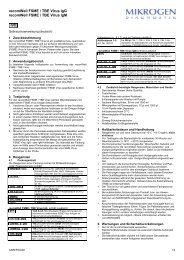

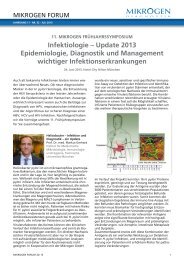

![recomLine EBV IgG [aviditet] [IgA] recomLine EBV IgM - Mikrogen](https://img.yumpu.com/19720026/1/184x260/recomline-ebv-igg-aviditet-iga-recomline-ebv-igm-mikrogen.jpg?quality=85)
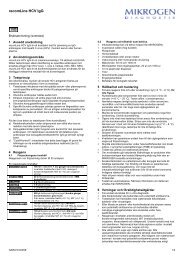
![recomBlot CMV IgG [Avidità] - Mikrogen](https://img.yumpu.com/16294013/1/184x260/recomblot-cmv-igg-avidita-mikrogen.jpg?quality=85)
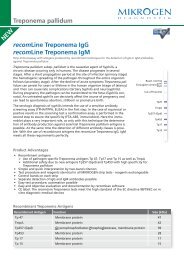
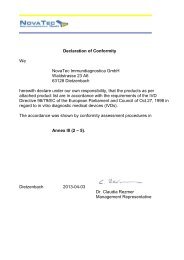
![recomBead Yersinia IgG recomBead Yersinia IgA [IgM] - Mikrogen](https://img.yumpu.com/15461030/1/184x260/recombead-yersinia-igg-recombead-yersinia-iga-igm-mikrogen.jpg?quality=85)
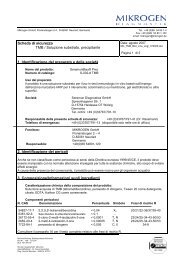
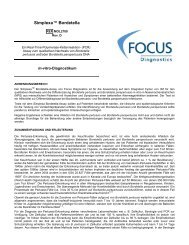
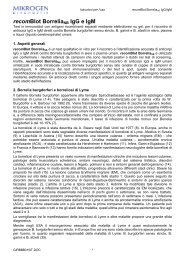
![recomLine EBV IgG [Avidity] [IgA] recomLine EBV IgM ... - Mikrogen](https://img.yumpu.com/6326010/1/184x260/recomline-ebv-igg-avidity-iga-recomline-ebv-igm-mikrogen.jpg?quality=85)